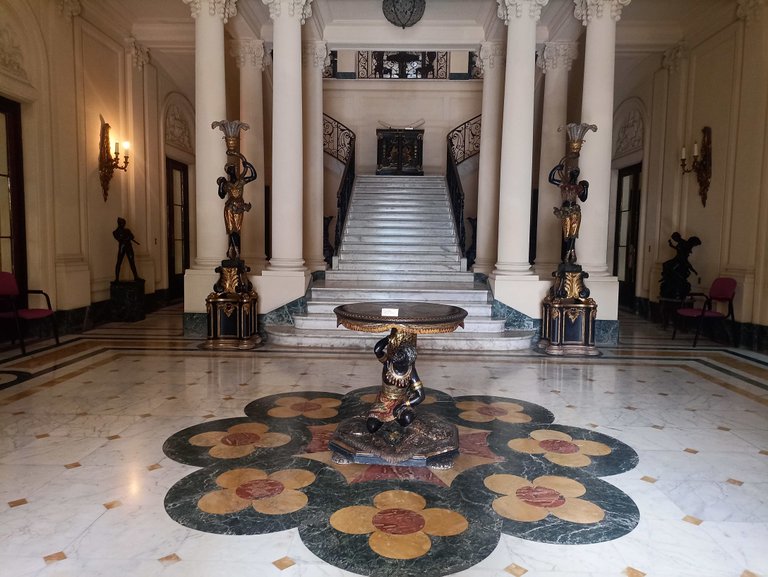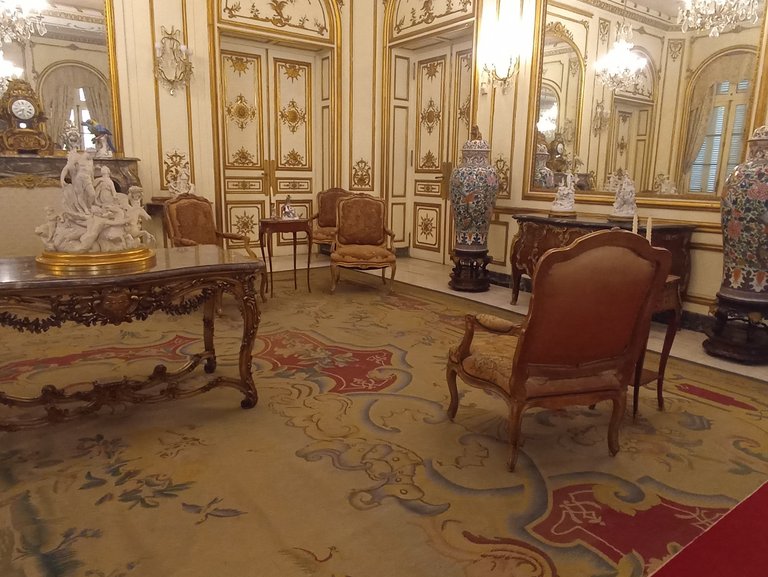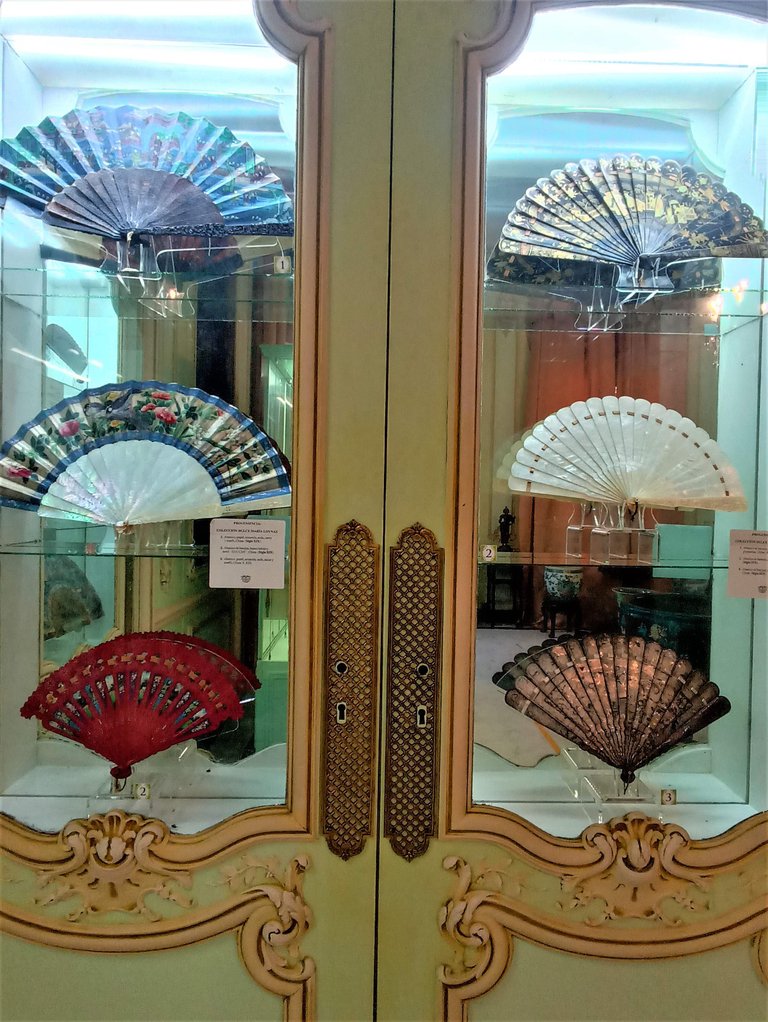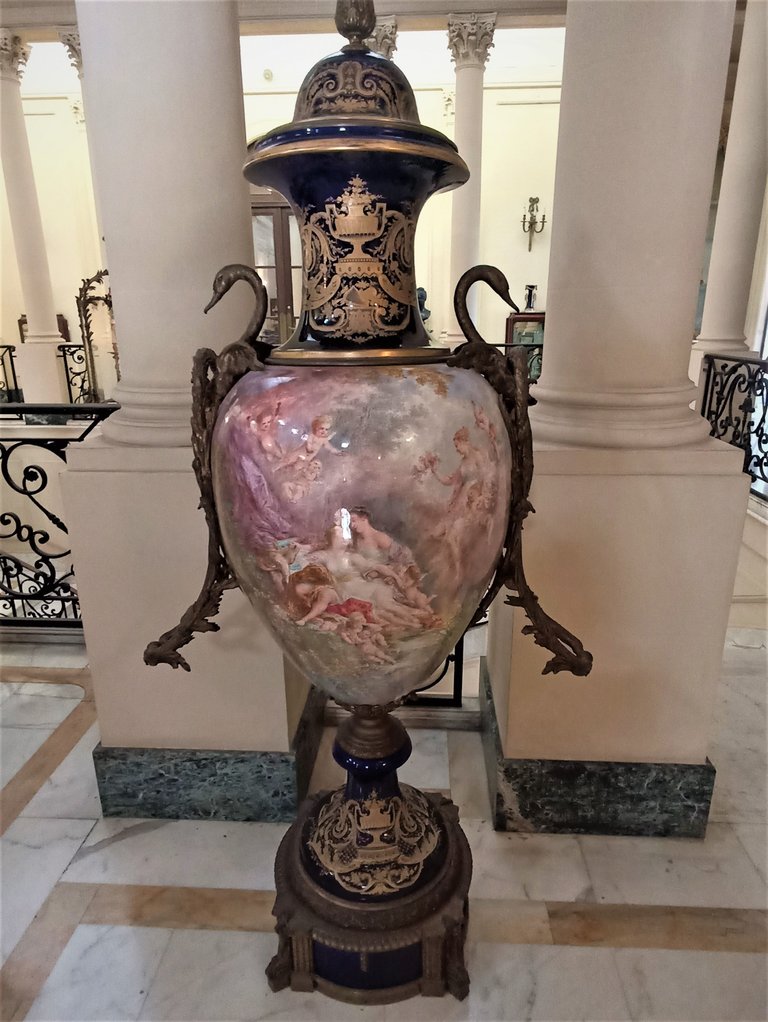

Dear friends, I want to share with you a very nice experience that I had when I visited a museum that is relatively close to my home, but for reasons of prioritizing daily routines I had never planned to visit it. It is the Museum of Decorative Arts that is located at 17th and D, in the heart of Havana's Vedado. Although from the outside you can admire its beautiful architecture, I was surprised by its well-kept and elegant interior beauty. In this post I would like to show you photos of some works and the different styles found in the salons, which I learned about with this visit.


When I arrived at 10 AM there were several people with the same objective of getting to know the museum. When we entered, a guide was ready to accompany us to explain all the history of the place and its exhibits. He told us that the house was built in 1927, it was designed by French architects in an Eclectic style simulating the style of the eighteenth century.
The museum is dedicated to exhibiting works of decorative art that correspond to the seventeenth to the twentieth centuries. A large number of pieces belonged to its previous owner, María Luisa Gómez Mena, Countess of Revilla de Camargo, who was a great art collector.
From the entrance we see a beautiful marble staircase and from the center you can see the upper floor at its entire diameter. The furniture and decoration of the hall come from Italy and France in the eighteenth and nineteenth centuries.


When entering the main room, we can notice the heating it has, in my country it is not used due to our tropical environment, but in this case it is needed to eliminate the high humidity that is in the place, thanks to this everything is preserved very well. We can only walk the red carpet so as not to damage the original carpet that is handmade and dates back to 1722.
He tells us that the decoration is in the Rococo style and is preserved with all the furniture and works of art exactly as the countess left it. I am very struck by the golden marquetry and the guide tells me that it is called gold leaf.



The dining room has a Regency style design, uses metals such as gilded bronze, precious woods for decoration and marble on the floor and walls. On the table is an elegant tableware, which is different every year because the collection of tableware is changed every May 18 to celebrate International Museum Day.





The rest of the rooms were used to exhibit valuable decorative works. We visit the room dedicated to oriental art that treasures pieces from the sixteenth to the twentieth centuries, we can appreciate a beautiful screen from the seventeenth century among other beautiful works.



I was surprised to find some copies of the collection of fans of the Cuban poet Dulce María Loynaz, I am an admirer of her poetry and I did not know that she had a collection of 1500 fans in total, including those inherited from her grandmother and her mother. Here are some of them that are of Chinese origin.

And now I present you the most interesting part of the museum. In the neoclassical living room there is a beautiful Secretaire that belonged to Queen Marie Antoinette before being owned by the Countess of Revilla, who bought it at auction in Paris in 1950, it is a piece of precious wood furniture designed expressly for the queen, with multiple secret drawers with locks to store important documents and that also unfolds as a desk.






There are also other objects that caught my attention, a thermometer-barometer that was used to know the weather conditions through the data it provides on atmospheric pressure and temperature. A beautiful ivory hunting horn of French origin from the year 1640 and a music box that is 130 years old and still works, I was thrilled when I was able to listen to its music.



I really felt very satisfied to have visited this museum and learn about the entire history of the works of art that it treasures, I also learned about the different styles of architecture and design that have existed, it is never too late to learn.
It is my wish that you liked to know about it, for me it was a pleasure to share it with you.

To know other data you can consult this site.
See you soon!

Estimados amigos quiero compartir con ustedes una experiencia muy bonita que viví al conocer un museo que está relativamente cerca de mi casa, pero por razones de dar prioridad a rutinas diarias nunca había planificado visitarlo. Se trata del Museo de Artes Decorativas que se encuentra en 17 y D, en el corazón del Vedado habanero. Aunque desde el exterior se puede admirar su hermosa arquitectura me sorprendió su belleza interior bien cuidada y elegante. En esta publicación me gustaría mostrarles fotos de algunas obras y de los diferentes estilos que se encuentran en los salones, sobre lo cual aprendí con esta visita.
Al llegar a las 10 AM había varias personas con el mismo objetivo de conocer el museo. Al entrar una guía se dispuso a acompañarnos para explicar toda la historia del lugar y de sus objetos expuestos. Nos comentó que la casa fue construida en 1927, se diseñó por arquitectos franceses con estilo Ecléctico simulando el estilo del siglo XVIII.
El museo se dedica a exponer obras de artes decorativas que corresponden a los siglos XVII al XX. Una gran cantidad de piezas pertenecían a su anterior dueña, María Luisa Gómez Mena, Condesa de Revilla de Camargo, quién era una gran coleccionista de arte.
Desde la entrada vemos una hermosa escalera de mármol y desde el centro se puede divisar el piso superior a todo su diámetro. Los muebles y el decorado del recibidor provienen de Italia y Francia de los siglos XVIII y XIX.
Al entrar a la sala principal podemos notar la calefacción que tiene, en mi país no se utiliza debido a nuestro ambiente tropical, pero en este caso se necesita para eliminar la alta humedad que hay en el lugar, gracias a ello es que se conserva todo muy bien. Solo podemos caminar por la alfombra roja para no dañar la alfombra original que es hecha a mano y data de 1722.
Nos comenta que la decoración es de estilo Rococó y está conservada con todos los muebles y obras de arte exactamente igual a como la dejó la condesa. Me llama mucho la atención la marquetería dorada y me dice la guía que se denomina pan de oro.
El salón correspondiente al comedor tiene un diseño de estilo Regencia, utiliza metales como el bronce dorado, maderas preciosas para la decoración y mármol en el piso y paredes. En la mesa se exhibe una vajilla elegante, que cada año es diferente porque se cambia la colección de vajilla cada 18 de mayo para celebrar el Día Internacional del Museo.
El resto de los salones se emplearon para exhibir valiosas obras decorativas. Visitamos el salón dedicado al arte oriental que atesora piezas de los siglos XVI al XX, podemos apreciar un hermoso biombo del siglo XVII entre otras bellas obras.
Me sorprendió encontrar algunos ejemplares de la colección de abanicos de la poetisa cubana Dulce María Loynaz, yo soy admiradora de su poesía y no sabía que ella tenía una colección de 1500 abanicos en total, incluyendo los heredados de su abuela y su madre. Aquí se muestran algunos de ellos que son de origen chino.
Y ahora les presento lo más interesante del museo. En el salón neoclásico se encuentra un hermoso Secretaire que perteneció a la reina María Antonieta antes de ser propiedad de la condesa de Revilla, quien la compró en una subasta en Paris en 1950, es un mueble de madera preciosa diseñado expresamente para la reina, con múltiples gavetas secretas con cerraduras para guardar documentos importantes y que además se despliega como escritorio.
También hay otros objetos me llamaron la atención, un termómetro-barómetro que se utilizaba para conocer las condiciones meteorológicas a través de los datos que proporciona de la presión atmosférica y la temperatura. Un hermoso cuerno de caza de marfil de origen francés del año 1640 y una caja de música que tiene 130 años y aún funciona, me emocionó cuando pude escuchar su música.
Realmente me sentí muy satisfecha de haber visitado este museo y conocer toda la historia de las obras de arte que atesora, además aprendí sobre los diferentes estilos de arquitectura y diseño que han existido, nunca es tarde para aprender.
Es mi deseo que les haya gustado conocerlo, para mí fue un placer compartirlo con ustedes.
¡Hasta pronto!






